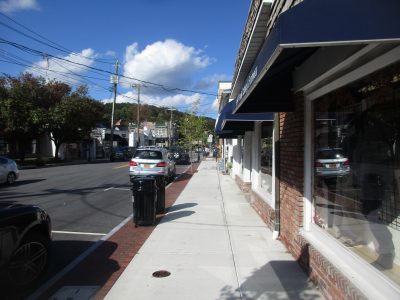Concerns Raised Over Proposed Zoning Code for Downtown Chappaqua

New Castle held the first of three public engagement sessions on the proposed form-based code for the Chappaqua business hamlet last Tuesday, but some residents questioned why officials were pursuing a potentially sweeping change for the downtown.
The live-streamed session that attracted about 60 viewers came four days after the Town Board accepted the Draft General Environmental Impact Statement (DGEIS) on the form-based code. The main features of the proposed code, which emphasizes the appearance and form of buildings rather than specific uses for each property, would allow for mixed-use development in the heart of the Chappaqua hamlet areas, permitting five-story buildings in limited areas and a streamlined approval process.
The process is an outgrowth of the public engagement sessions held in 2014 for the updated Comprehensive Plan adopted three years later, where public feedback focused on reinvigorating downtown. The code takes in the area along North and South Greeley Avenue from Washington Avenue to Bischoff Avenue, lower King Street and an area farther up King Street across from Walgreen’s.
“We’re doing this now because we have 17, 17 vacant storefronts in the Chappaqua hamlet,” said Town Supervisor Ivy Pool. “We are doing this now because there is significant demand for residential housing units as people flee the city during the pandemic, and perhaps forever more. We are doing this now because the community – this community, New Castle – cannot and will not sit back on our heels while surrounding towns and villages revitalize their downtowns.”
However, several speakers, who were among about a dozen residents who spoke during the session, expressed skepticism about the plan, pointing to the potential for drastic change to the town.
One part of the plan would allow development of up to five stories on the west side of South Greeley Avenue and on town-owned property at the train station.
They were also concerned after Director of Planning Sabrina Charney Hull said that the theoretical maximum buildout under the plan, which is required by the state to be included in the town’s environmental review, could spur 997 new residential units, 1,856 additional residents and an estimated net increase of 96 additional schoolchildren. It would also add 20,888 square feet of commercial space.
Resident Arleigh Venet said he didn’t understand why the town wants more development downtown.
“Development is a myth. You think you’re doing good when you develop,” Venet said. “It’s a myth. You’re potentially going to be ruining a town. I don’t understand what is driving the proposal of developing the hamlet. Why can’t you figure out another place to put the residential spaces?”
Chappaqua resident Lynne Lambert said many people in town don’t even know the Town Board is considering such significant changes. She said the town should maintain the current building height limits.
Although many people who attended the public sessions that led to the Comprehensive Plan update wanted an improved downtown, many would unlikely agree to the potential overhaul, Lambert contended.
“I don’t think, if you took a poll, people would say they wanted to completely change the look of our downtown,” she said.
Another resident, Robin Klein, questioned whether the influx of extra residents, with added schoolchildren, would benefit the town because it could cause school taxes to increase.
Last Wednesday night, the Chappaqua Board of Education expressed concern about the impact of potentially adding nearly 100 additional schoolchildren, unconvinced that is an accurate estimate.
Board President Victoria Tipp said the district’s focus has been on managing the schools through the pandemic. District officials only received the DGEIS last Tuesday, she said.
Pool said it is unlikely the town would ever reach maximum buildout because it would require the consolidation of private property and the sale of town-owned property. The latter would be subject to a permissive referendum.
Councilman Jeremy Saland stressed that what the town is considering is a zoning change to attract development, and the form-based code is not a building development plan. He added that New Castle cannot afford to remain stagnant.
“Keeping (the downtown) the way it is now is guaranteed to fail in my view,” Saland said. “It will fail and then it hurts everybody, so if this is going to grow and expand and there is going to be construction over the next 15 years in pieces or in large scale, we want to find a way to make it work.”
The two remaining public engagement sessions are this Thursday, Oct. 8 from 4 to 5:30 p.m., where visual and transportation impacts will be discussed, and on Thursday, Oct. 15 from 10 to 11:30 a.m., which will feature alternatives to the proposed plan.
A public hearing on the DGEIS will open on Oct. 20.
To learn more about the plan and to register to view the remaining engagement sessions, visit www.chappaquaforward.com.

Martin has more than 30 years experience covering local news in Westchester and Putnam counties, including a frequent focus on zoning and planning issues. He has been editor-in-chief of The Examiner since its inception in 2007. Read more from Martin’s editor-author bio here. Read Martin’s archived work here: https://www.theexaminernews.com/author/martin-wilbur2007/
